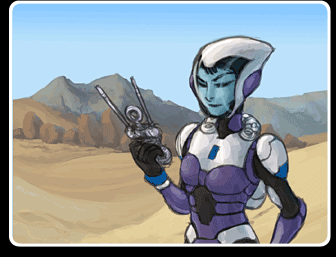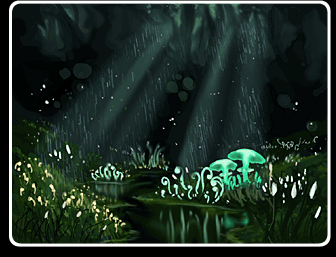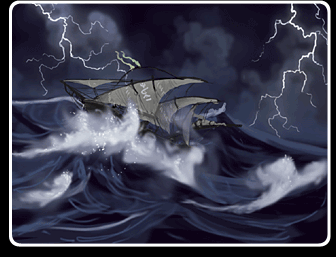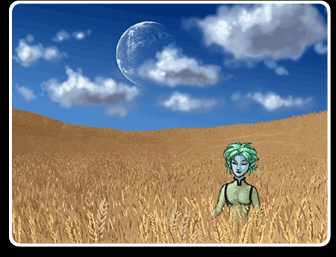|
Data File Updated: Sunday, July 29, 2018 The "Sister Worlds" usually refer to the three original Loroi Splinter Colonies (Deinar, Perrein and Taben), but sometimes include Mezan (a colonized inner planet of the Deinar system) and Maia, a later but large colony that is sometimes called the "Fourth Sister." Here are some brief notes on these four key star systems and their respective Loroi cultures. (See main article: Loroi) Deinar
Deinar has only very primitive native life, at the microbial stage and restricted to the seas. The land is dominated by imported Soia-Liron life forms and their descendants. Soia-era ruins are relatively common on Deinar, so even in the “ancient” period, many high-tech items were known, and the Loroi always had a cultural sense of being the descendants of an earlier civilization. Deinar is a temperate world that sports a wide variety of climes, and accordingly Deinarid Loroi are found in many shapes, sizes and hues, and are roughly divided into three major racial groups: the Barraid, Tadan and Login. A non-Loroi would probably not notice the differences between the three. The Barraid inhabited the western highlands of Mestirot and are reputed to be tall and athletic, usually fair-skinned. The Tadan inhabited the central river valleys and are darker-skinned but also tall, and have a reputation for beauty. The Login are widely distributed and are shorter and wiry, with a reputation for toughness. All three races have similar martial traditions. The various nation-states on Deinar had a long and contentious history of warfare prior to the reunification of the Splinter Colonies, and had developed a complex set of warrior castes. The Torrai, Soroin, and Teidar castes all have their roots on Deinar, as do the Farseer and Philosopher castes. The largest number of modern Loroi with psychokinetic abilities can trace their ancestry to Deinar. Deinar has always been at the center of Loroi political and cultural life. Prior to the colonization of Maia, Deinar held the largest population of Loroi (about 1 billion in 850 CE), and it has since more than doubled. The Imperial Capital, the city of Toridas is located in the Barraid nation of Zaral on the west coast of Mestirot. All four of the Loroi Emperors have been natives of Deinar. The Teidar Academy is located at Redcliff Falls in the highlands above Toridas. The ancient Tadan city of Menelos (located in the Arran river valley) is still considered the cultural center of the empire, and is home to the Soroin caste headquarters. Mezan
Mezan currently supports a very small Loroi population, mostly in underground habitats, and is home to various research academies, including the primary academy for the Listel caste, located at Upway, in the mountains near the southern pole. The Mezan Loroi are of mixed genealogy from Deinar III and across the empire, mostly having emigrated to Mezan to attend the local academies or engage in research. SemosetOne of the most famous features of the Deinar system is Semoset, the mother of all comets. It is a Pluto-sized icy dwarf planet that visits the inner system every 28 years on a highly elliptical and eccentric orbit. The massive comet-like tail that is thrown off when Semoset passes near the star stretches for more than a hundred million kilometers, and fills the nighttime sky both on Deinar and Mezan. It has influenced the legends of all the Deinar nations, and the holiday that marks its passing is among the most important in modern Loroi culture. Semoset has an orbit resonant with that of Azerein (Deinar V), a great ringed gas giant that dominates the outer Deinar system, bracketed by great debris rings. The outer ring, similar in composition to the Kuiper belt but much larger, is filled with icy bodies similar to Semoset, and is almost certainly its origin. PerreinPerrein's primary is older than our sun, and moonless Perrein is in a relatively close orbit (still within a Terran-style biozone) and has little axial tilt, and so little seasonal change. The climate is hot and wet; although the seas on Perrein are relatively small, much of the "dry" land is ancient limestone-like rock that is saturated by a vast planet-wide underground aquifer. Perrein is home to a sophisticated native ecosystem that has evolved through plants to higher land animals. The heat from direct sunlight is mitigated at the surface by the canopy of monstrous foliage. The Perrein day is longer than Earth's.
Perrein was home to a relatively small (~200 million) population in 803 CE when they were detected by Farseers from Deinar. Loroi settlements on Perrein tended to be small, dispersed and somewhat insular. As on Deinar, Perrein knew constant warfare between its city-states, but because of the hostile and dispersed geography, conflicts usually consisted less of clashes between large armies, and more of savage diplomacy and the long-range operations of guerrilla-style pioneer units. The Mizol were Perrein’s equivalent of the Teidar, and the caste still has its headquarters here in the city-state of Aesha. Physically, Perrein Loroi are of medium height, and often have dark hair and larger than average ears. Perrein Loroi from the sunlit upland regions have very dark skin, while those from the jungle-covered shadowlands are ghostly pale and have good low-light vision. Without the abundance of Soia-era ruins or artifacts available on Deinar or Taben, Perrein technology was comparatively primitive, and without Soia texts as a baseline, the Perrein dialect of Trade was barely recognizable during contact; however, the Perrein Loroi have perhaps the strongest spoken tradition among the Loroi, and have a reputation for being easy to communicate with (if not always easy to trust). Perrein is also home to one of the only major native religions known to the Loroi. Perrein produces formidable telepaths, and has the highest occurrence of psychokinetic abilities as a percentage of any Loroi population, though Perreinid psychokinetics tend to be of lower power-levels. Many telepathic technique schools are still based here, as is the Mizol academy. Although at the time of reunification the population of Perrein represented nearly a quarter of all Loroi, since then the population of Perrein has grown the least of the three Sister worlds, and is still less than half a billion. More than any of the other Loroi cultures, the Perrein Loroi have enjoyed a truly exotic diet of weird native creatures from their world. Their unusual palates are often the subject of jokes; it is said that it’s impossible to turn a Perrein Loroi's stomach. TabenTaben is an ocean-covered world, with relatively small land masses. Taben's primary (G2V) is about the same age as our Sun, and while moonless, Taben has an axial tilt similar to Earth's that indicates a massive impact in primordial times, and causes significant seasonal change in climate. The preponderance of surface water helps to mitigate the effects of seasonal change, but there are still major differences in the climate zones between the cold northern continent (Beleri) and the warmer equatorial islands (Amenal). The shallowness of the southern seas also helps to make them much calmer than the deeper, stormy northern seas. Taben's rotational period is shorter than Earth's, with no moons to help slow it down over the eons. Taben has a wealth of native life forms as advanced as primitive fish, but few land-based animal species. Not surprisingly, Taben is known for its variety of seafood, and sea-greens form the traditional staple of the Taben Loroi diet. The small continent of Beleri is cold and rocky, heavily forested with native evergreens, often covered deep in snow during the truly epic winter storms. Active geothermal regions provide pockets of ice-free land year round, and rocky fjords shelter excellent deep-water ports. The Amenal islands are sub-tropical and much less harsh, but also much smaller in land area. The seas around Amenal are comparatively shallow and calm, but elsewhere on the planet the oceans can be very deep, with massive global currents and frequently fierce weather.
Though Taben was the last of the three Splinter Colonies to be contacted by the re-emerging interstellar Loroi civilization (92 years after the initial telepathic contact between Deinar and Perrein), the southern islands of Amenal were the first Loroi to regain some degree of high technology after the Fall, thanks to the large quantity of Soia-era artifacts littering the shallow ocean floor nearby. Taben is still a major research center, and the second of the major Listel academies is located here in Amenal on the island of Soladra, along with a substantial underwater Pipolsid research colony. The Tenoin caste also has its traditional roots here, and is headquartered in an orbital facility (Anchorage Citadel), with additional campuses in Beleri. Taben exports large quantities of marine products, and is an important shipbuilding center. Alone among the three colonies, Taben did not have a constant history of inter-tribal conflicts, aside from the occasional northern pirate raids on the southerners. The elements were a strong challenge in and of them themselves, and the communities were widely dispersed, but traded frequently. Taben had by far the smallest population of the three Splinter World, and also the lowest occurrence of psychokinetic abilities in the population. As a result, the Tabenid Loroi have often perceived themselves to be treated as the junior partners in the alliance. Because of their perceived cultural differences and traditions of isolationism and independent self-rule, Taben has often been a seat of dissent against the Imperial system, among the Belerid Loroi in particular. In each of the two major Loroi civil conflicts, Tabenid Loroi have formed a significant part of the rebel faction. Today, many of the members of the Loroi Axis, the opposition party, continue to be from Taben. Taben today still does not have a single global government. Beleri is united as a single state with its capital at the port of Sezabi, but the island-states of Amenal are still technically independent nations, aggregated into a loose economic federation. Maia
Maia was located in disputed territory between the Mannadi and Pipolsid empires, and sits on the major route into the southern section of what is now Union territory. The Loroi attempted to resolve the dispute by claiming Maia for themselves, establishing a farming colony there in 1311 CE. Cut off from further expansion into the southern sector, the Mannadi began to further encroach on Pipolsid and Neridi territory, which inevitably led to a long and costly series of wars between the Mannadi and the Loroi and their allies. Maia is now the capital of this southern sector which has come to be called the Maiad Sector. The term “Maiad Loroi” is both a cultural and a biological classification; it is used both to refer to the culture of Maia specifically and also to biologically classify Loroi of mixed descent who do not fall into the traditional three ethnic categories of the original Splinter Colonies. Maia was the first Loroi world to have reproductive restraints almost completely released, which in addition to producing a population explosion had a powerful impact on local culture. Maia culture is the “melting pot” of the Loroi Empire, and tends to be more easy-going than the relatively uptight Sister worlds. Maia is currently by far the most populous Loroi world, and continues to enjoy relaxed reproductive controls (in comparison to other Loroi worlds), and it continues to be a major source of emigrant population for the rest of the empire. Even with such a large population, much of Maia is still utilized as farmland, and farm produce and various biological products are the primary Maiad export. Maia has a few very large cities, and much of the population is dispersed across the planet's vast surface area in smaller towns and rural communities. DoneiMaia's large moon also supports a colony of its own. Donei is about the size of Titan (6,000 km in diameter), but is much denser, with an iron core and a surface gravity of about one-quarter g. It has a thin atmosphere due to the lower gravity, and is quite arid, with only a few small seas, but otherwise is suitable for habitation, with an oxygen atmosphere and a functioning biome of imported Soia-Liron organisms. It is believed that Donei was moved into orbit around Maia roughly one million years ago by the Dreiman; prior to that, it was probably a planet of the inner solar system, or perhaps a moon of one of the outer gas giants. Due to the relative scarcity of water, Donei is not ideal for agriculture -- but with Maia being the breadbasket of the empire, that is not a problem. Mining and heavy industry has thrived here, and it is an ideal site for building spacecraft (with its low gravity). Much of Donei is heavily urbanized, with many cities that might have been built on Maia being built here instead. Donei has also earned a reputation as a haven for entertainment centers and businesses that might not be welcome on more culturally conservative worlds. If Maia is the California of the Loroi empire, then Donei is the Nevada analogue. See also: Loroi, Loroi Timeline, System Defenses |
![]()
1
2
3
4
5
6
7
8
9
10
11
12
13
14
15
16
17
![]()
18
19
20
21
22
23
24
25
26
27
28
29
30
31
32
33
34
35
36
37
38
39
40
41
42
43
44
45
46
47
48
49
50
51
52
53
54
55
56
57
58
59
60
61
62
63
64
65
66
67
68
69
70
71
72
73
74
75
76
77
78
79-80
81
82
83
84
85
86
87
88
89
90
91
![]()
92
93
94
95
96
97
98
99
100
101
102
103
104
105
106
107
108
109
110
111
112
113
114
115
116
117
118
119
120
121
122
123
124
125
126
127
128
129
130
131
132
133
134
135
136
137
138
139
140
141
142
143
144
145
146
147
148
149
150
151
152
153
154
155
156
157
158
159
160
161
162
163
164
165
166
167
168
169
170
171
172
173
174
175
176
177
178
179
180
181
182
183
184
185
186
187
188
189
190
191
192
193
194
195
196
197
198
199
![]()
200
201
202
203
204
205
206
207
208
209
210
211
212
213
214
215
216
217
218
219
220
221
222
223
224
225
226

 Deinar's primary star is relatively young, and so there is still a
lot of dust and debris in the inner orbits of the system, and
comet and meteor impacts are common (though mitigated by modern
countermeasures). Deinar III (also called just "Deinar") is a
temperate terrestrial world, though cooler and more arid than
Earth (with larger ice caps and a narrower temperate zone), and with a thinner atmosphere. Deinar has a shorter day
than Earth. Most of Deinar's land mass is collected into a large
Pangaea-like supercontinent called
Deinar's primary star is relatively young, and so there is still a
lot of dust and debris in the inner orbits of the system, and
comet and meteor impacts are common (though mitigated by modern
countermeasures). Deinar III (also called just "Deinar") is a
temperate terrestrial world, though cooler and more arid than
Earth (with larger ice caps and a narrower temperate zone), and with a thinner atmosphere. Deinar has a shorter day
than Earth. Most of Deinar's land mass is collected into a large
Pangaea-like supercontinent called
 Deinar II, also called Mezan, is a hot, dusty wasteland that
was the first world to be colonized by the Deinar Loroi after the redevelopment of spaceflight.
Moonless Mezan is uncomfortably close to the system primary, but
it was heavily terraformed some time in the pre-Fall past, and
so is marginally habitable, though still mostly unsuited for
life outside the underground habitats. Mezan has about
two-thirds of Earth's mass, and a surface gravity just over
one-half g. It is extremely dry, and the temperature on
the surface swings wildly between day and night. The atmospheric
pressure is very similar to that of Deinar, but has
very little oxygen (without much plant life to sustain it), and
so Loroi can survive on the surface without pressure suits,
though they will usually need an external oxygen supply to work
outside for any extended period. It is not clear why this world was
inhabited during the Soia era, but the ruins from that era clearly
demonstrate that it was, and the
artifacts are well preserved in the dry conditions. Study of
these artifacts was and continues to be the primary reason for
the existence of the Loroi colony here. Discoveries
here led directly to the development of many Loroi advances,
including the psionic amplifiers which later enabled detection
of the other Sister Worlds and eventually spurred the Loroi to
redevelop starflight.
Deinar II, also called Mezan, is a hot, dusty wasteland that
was the first world to be colonized by the Deinar Loroi after the redevelopment of spaceflight.
Moonless Mezan is uncomfortably close to the system primary, but
it was heavily terraformed some time in the pre-Fall past, and
so is marginally habitable, though still mostly unsuited for
life outside the underground habitats. Mezan has about
two-thirds of Earth's mass, and a surface gravity just over
one-half g. It is extremely dry, and the temperature on
the surface swings wildly between day and night. The atmospheric
pressure is very similar to that of Deinar, but has
very little oxygen (without much plant life to sustain it), and
so Loroi can survive on the surface without pressure suits,
though they will usually need an external oxygen supply to work
outside for any extended period. It is not clear why this world was
inhabited during the Soia era, but the ruins from that era clearly
demonstrate that it was, and the
artifacts are well preserved in the dry conditions. Study of
these artifacts was and continues to be the primary reason for
the existence of the Loroi colony here. Discoveries
here led directly to the development of many Loroi advances,
including the psionic amplifiers which later enabled detection
of the other Sister Worlds and eventually spurred the Loroi to
redevelop starflight. A large swath of the surface of Perrein north and south of
the equator is dominated by a vast jungle of monstrous fungal
trees. Oxygen levels are very high, similar to what existed on
Earth during the Carboniferous era, and this oxygen powers
exotic and sometimes equally monstrous fauna. In the rocky
highlands, outcroppings of land can reach sunlight, but in the
lowlands and plains the surface is almost totally obscured from
the sun by the dense, high canopy of foliage. These lowlands
have become a shadow land of bioluminescent plants and animals,
and a host of deadly predators in the perpetual night. Despite
the heavy rainfall in many areas, there are few freshwater lakes
and rivers (most water flows into the saline aquifers
underground), and the lack of arable land has always kept the
Loroi population of Perrein fairly small and mostly dispersed.
A large swath of the surface of Perrein north and south of
the equator is dominated by a vast jungle of monstrous fungal
trees. Oxygen levels are very high, similar to what existed on
Earth during the Carboniferous era, and this oxygen powers
exotic and sometimes equally monstrous fauna. In the rocky
highlands, outcroppings of land can reach sunlight, but in the
lowlands and plains the surface is almost totally obscured from
the sun by the dense, high canopy of foliage. These lowlands
have become a shadow land of bioluminescent plants and animals,
and a host of deadly predators in the perpetual night. Despite
the heavy rainfall in many areas, there are few freshwater lakes
and rivers (most water flows into the saline aquifers
underground), and the lack of arable land has always kept the
Loroi population of Perrein fairly small and mostly dispersed.  Taben
has two distinct racial groups: the fair-skinned
deep-water sailors on Beleri, and the darker equatorial
islanders who inhabit
the Amenal archipelago. The northern group in particular is
known for being fair-skinned and thin, and with large noses. Yellow eyes are normally a trait unique to the Belerid Loroi. The sailors on the stormy northern seas enjoyed a
long tradition of heroic seamanship, from fishing and “whaling”
to trading and exploring, and even raiding and piracy. In the
warmer, calmer equatorial islands of Amenal, where the seas are
shallow in places, the Amenal Loroi often dived in search of
reef organisms, and for ancient Soia treasure and artifacts. Loroi resistance to pressure and their
efficient metabolisms allowed Amenal divers to descend to
remarkable depths, long before the development of submersibles.
The southern islands became a center of trade and learning (and
a target of northern raiders). While by the time of the contact
in 895 CE the Amenal were living in
fairly high-tech islandic and aquatic habitats, many Belerid
still sailed wooden ships. Because of the limited amount of
arable land and the frequency of disastrous weather events, population in
pre-contact Taben never got much above 50 million, and was
perhaps as small as 30 million at the time of contact.
Taben
has two distinct racial groups: the fair-skinned
deep-water sailors on Beleri, and the darker equatorial
islanders who inhabit
the Amenal archipelago. The northern group in particular is
known for being fair-skinned and thin, and with large noses. Yellow eyes are normally a trait unique to the Belerid Loroi. The sailors on the stormy northern seas enjoyed a
long tradition of heroic seamanship, from fishing and “whaling”
to trading and exploring, and even raiding and piracy. In the
warmer, calmer equatorial islands of Amenal, where the seas are
shallow in places, the Amenal Loroi often dived in search of
reef organisms, and for ancient Soia treasure and artifacts. Loroi resistance to pressure and their
efficient metabolisms allowed Amenal divers to descend to
remarkable depths, long before the development of submersibles.
The southern islands became a center of trade and learning (and
a target of northern raiders). While by the time of the contact
in 895 CE the Amenal were living in
fairly high-tech islandic and aquatic habitats, many Belerid
still sailed wooden ships. Because of the limited amount of
arable land and the frequency of disastrous weather events, population in
pre-contact Taben never got much above 50 million, and was
perhaps as small as 30 million at the time of contact.  Maia is a large planet with a welcoming climate that was
extensively terraformed over the course of several
Maia is a large planet with a welcoming climate that was
extensively terraformed over the course of several